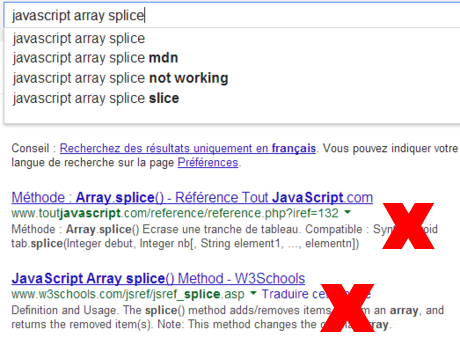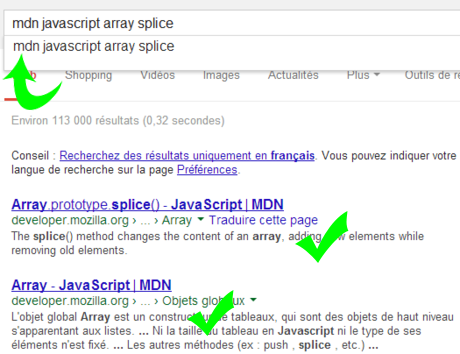JavaScript
Past, Present, Future
JavaScript public release
A complement to Java
for easy online application development
History (1996 - 2006)
- 1996
- Microsoft : JScript
- 1997
- IE4/NN4 : DOM (DHTML)
- ECMAScript
- 1999
- IE5 : XMLHttpRequest (AJAX)
- ECMAScript3 (~JS 1.5)
- Adobe : ActionScript
- 2001 - 2006

- 2004

2008 : Google Chrome

Built on V8 JavaScript engine
Browsers war focuses on JavaScript engine speed
2009 : ECMAScript 5
ES5 is mostly a compatibility version (ES4 was abandonned)
JSONsupport- New
ArrayandObjectmethods "use strict"to convert mistakes into errorsFunction.prototype.bind
2009 : JavaScript out of the browser
NodeJS : to rule them all
JavaScript : 3 Key concepts
- Functional
- Inheritance
thisvalue
Key concepts : Functional language
Functions...
- Inherit from
Object+ own executable code - Can be wherever an
Objectcan be - Can be parameter of other functions
- Are factory of objects when constructors :
newoperator - Behavior can be adjusted at execution time
Key concepts : inheritance
JavaScript does not use classical inheritance
JavaScript uses Prototype inheritance
You should learn Prototype inheritance
Key concepts : prototype inheritance
-
Gentleman prototyping
function Gentleman(){}; Gentleman.prototype.sayHello = function(){ console.log("Hello Sir"); } -
Gentleman instantiating
var gentleman = new Gentleman(); gentleman.sayHello(); // 'Hello Sir' -
Prototype modification
Gentleman.prototype.sayHello = function(){ console.log("What's up dude ?"); } -
Modification apply to existing instance
gentleman.sayHello(); // What's up dude ?
Key concepts : this value
function foo(){
console.log(this); // What is `this` ?
} // Looking at this, we can't say.
The value of this in a function
only depends on its invocation mode*
not on its declaration
* There are 4 invocations modes
Key concepts : this value
- As a function
foo(); //this === window - As a method
bar.foo(); //this === bar - As a constructor
new foo(); //this === [new built and returned object] - With
call&applyfoo.call(baz); //this === baz foo.apply(baz); //this === baz
Exceptions : Function.protoype.bind and Arrow function expressions
Other key concepts
- Dynamic typing
- Global scope
- Variable scope and hoisting
- Closure
- ... and much more
2014 : ECMAScript 6
- Code name Harmony
- Target publication date : December 2014
- Upgrades JS to fit other modern languages
- Brings new powers to developers
Some features already available
- ... in some browsers
- ... in NodeJS :
node --harmony
ES6 : New features' pick list
ES6 : Destructuring assignement
Extract data from arrays or objects using a syntax that mirrors
the construction of array and object literals
var a, b;
[a, b] = [1, 2];
// a === 1
// b === 2
[a, b] = [b, a];
// a === 2
// b === 1
[a, ,b] = ["v", "w", "x"];
// a === "v"
// b === "x"
ES6 : Generators
Special functions that generate iterators
yield provoke partial returns
Can be resume with next method
function* greatGenerator(){
yield "Clermont'ech";
yield "is great";
for (var i = 0; i < 3; i++){
yield i*2;
}
}
var iterator = greatGenerator();
iterator.next(); // "Clermont'ech"
iterator.next(); // "is great"
iterator.next(); // 0
iterator.next(); // 2
ES6 : Generators
Generators introduce a new expression syntax
//Generator of positive integers iterator
function* posIntGenerator(){
var value = 0;
while (true){
yield value++;
}
}
var posIntIterator = posIntGenerator();
// New expression syntax below
var posIntBy2Iterator = (anInt * 2 for (anInt in posIntIterator));
posIntBy2Iterator.next(); // 0
posIntBy2Iterator.next(); // 2
posIntBy2Iterator.next(); // 4
posIntBy2Iterator.next(); // 6ES6 : Arrow functions
Arrow function expressions
are like function expressions
with shorter syntax
+ it binds this value
// This is an anomous function
function(){};
// No parameter, returns undefined
() => {};
// No parameter, returns "foo"
() => "foo"
// Single parameter, returns double
a => a * 2
// Two parameters, returns sum
(a, b) => a + b
ES6 : Modules
There was no built-in module concept in JavaScript
...but two standards :
...unfortunately they are not compatible
ES6 introduces another format
Trying to fill the gap
ES6 : Modules
Module definition
// calculator/lib/calc.js
const A_NOT_EXPORTED_CONSTANT = 7;
function multiply(x) {
return x * A_NOT_EXPORTED_CONSTANT;
}
// Public object exported
module.exports = {
multiply: multiply
};
Module import
// calculator/main.js
import { multiply } from 'lib/calc';
console.log(multiply(3));
Plus the new <module> tag for the browser
Example from http://www.2ality.com/2013/07/es6-modules.html
Other ES6 features
ES6 : Class
Class keyword but still Prototype inheritance
Sugar syntax to replace framework machinery
class Gentleman extends Dude {
constructor(name) {
super(name);
this.sayHello();
}
sayHello() {
console.log('Hello Sir');
};
}
}ES6 : Spread operators
Expression expands in places
where multiple elements are expected
function sum(a, b, c, d) {
return a + b + c + d;
}
var expandable = [4, 12, 7, 19];
sum(...expandable); // 42
var expandable2 = [-5, 8];
sum(1, ...expandable2, 20); // 24
var expandable3 = [...expandable, ...expandable2];
//[4, 12, 7, 19, -5, 8]
ES6 : const & let
Brings block scope variables and constantes
if (x) {
let foo;
const bar = 10;
// `foo` and `bar` are defined inside the if block
bar = 11; // Error
//the value of `bar` cannot change
}
ES6 : default parameters
You (may) used to write
function f(name, age) {
age = age || 18;
}You will write
function f(name, age = 18) {
}ES6 : Rest parameters
Representation of an indefinite number
of tailing arguments as an array
function sum(a, b, ...args) {
//args is an Array
var restSum = args.reduce(function(prev, current){
return prev + current;
}, 0);
return a + b + restSum;
}
sum(1, 2); // 3
sum(1, 2, 8); // 11
sum(1, 2, 8, 12); // 23
ES6 : Promises
Until now promises were provided by libraries
( jQuery, Q, Bluebird)
Promises are built-in ES6, they :
- Resolve asynchronous calls concurrency
- Simplify complex asynchronous code
- Help to adhere the 1st rule of object calisthenics
ES6 : Proxy
Proxies can change the default behavior
of an object
var proxyTraps = {
get: function(obj, prop) {
return 42;
}
};
var person = new Proxy({ age : 100 }, proxyTraps);
console.log(person.age); // 42
person.age = 18;
console.log(person.age); // 42
The proxyTraps.get is a 'trap' method
There are many others available
Useful for data validation, sanitization, dynamic code analysis...
ES6 : Map & WeakMap
Maps and WeakMaps are key/value maps
Where keys are objects
≠ JS native object : keys are string
var wm = new WeakMap(),
trivialeObject = {
'Clermont' : 'Ferrand'
};
wm.set(trivialeObject, 42);
wm.get(trivialeObject); // 42
wm.has(trivialeObject); // true
wm.delete(trivialeObject);
wm.has(trivialeObject); // false
ES6 : Promises
An example from jQuery with AJAX calls
$.getJSON('customers.json', function(customers){
$.getJSON('products.json', function(products){
console.log('We have ' + products.length + ' products');
console.log('and' + customers.length + ' customers');
});
});
//Synchronous sequence of async calls : bad pattern
var customersPromise = $.getJSON('customers.json'); //Returns a promise
var productsPromise = $.getJSON('products.json'); //Returns another promise
$.when(customersPromise, productsPromise)
.then(function(customers, products){
// Called only if both promises are resolved
console.log('We have ' + products.length + ' products');
console.log('and' + customers.length + ' customers');
});
ES6 is already old story
ES7 is coming next...
Where is JavaScript ?
In your shell with NodeJS,
in your OS with Windows Store App or Node webkit,
in your mobile with PhoneGap, FirefoxOS, Tizen,
in your things with Arduino or BeagleBone,
in the code compiled from C++, Java, C#... via Emcripten,
and in your websites, back and front, with a huge ecosystem.
Cool ! But... where is the doc ?
Don't forget to type mdn when Googling


Questions ?
Our community





